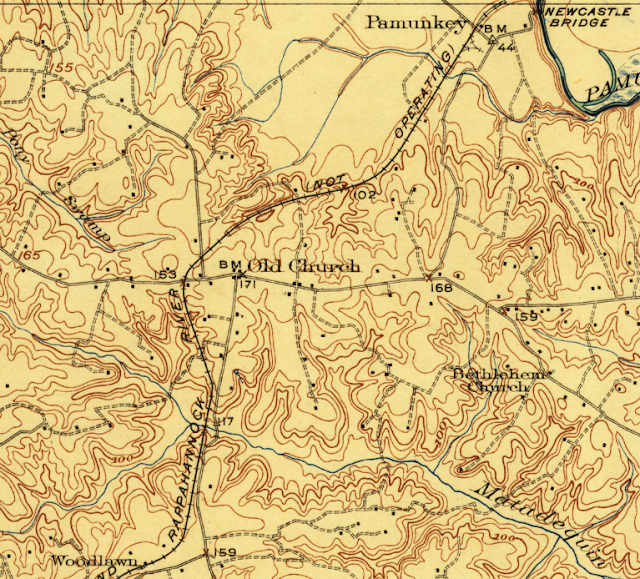The Richmond & Rappahannock River Railway
The Richmond & Rappahannock River Railway was chartered to run northeasterly from Richmond, VA to Tappahannock, VA in 1912. (Right of way)
In service for just five years, the railway served little other purpose other than a cautionary tale against the phrase "If you build it, they will come", as that isn't always grounded in reality. While this is a historical railroad that had the misfortune of being built right before World War I, there are numerous highway examples which have done little to spur development. But I digress.
 |
| USGS Historic Topo Map, King William, 1920. |
A 1915 newspaper article promoting the line advertised it, and its owner, the Richmond Land & Development Corporation in the following way: "An illustration of the expansion of its industrial activities in Richmond and to territory beyond its corporate limits, is in the enterprise of the Rappahannock Land and development Corporation, formed to open up a well located section. This feature will be greatly helped by the Richmond and Rappahannock Railway Company, which is building a steam and electric railroad extending from Richmond to tidewater on the Rappahannock River, a distance of seventy-five miles. This development has thrown open for further industrial expansion a section that embodies every manufacturing advantage, and the company is offering free sites along the line of this railroad, both in and adjacent to Richmond, as well as the territory through which the railway passes.
So far nearly $l,000,000 has been spent on this undertaking. Twenty-seven and one-half miles of the steam and electric railroad systems have been built [only about 16 actually were], extending through several small but thrifty communities, and an important truck farming section. Railroad shops have been constructed about two miles from Richmond, and these have been well equipped with the usual machinery for repairing and rebuilding cars and equipment. Passenger service is being handled by gas-electric cars and freight by regulation railroad freight cars and steam locomotives, physical connections having been made at Richmond with the Chesapeake and Ohio and the Southern Railways for the interchange facilities of carload freight to all parts of the country.
In addition to providing industries locating along the lines with free sites. the Richmond and Rappahannock River Railway Company will build without charge such sidetracks as will be needed for switching freight cars direct to their doors."
...What has been done, however, is but a beginning. and it is the intention to push this work steadily forward to its final completion, which will give to Richmond an opening for further industrial expansion, and will materially further its growth.
Nothing emphasizes so strongly the faith of a community in itself as the investment of large sums in such broad developments as these, and it has been this continued and steadfast belief in Richmond in its businessmen that has helped so much to make this city one of the most active and progressive in the South." (Richmond Times-Dispatch, 1915)
In spite of what was said in the newspapers however, the financial situation of the road was in dire straits. The railroad never was able to cross the Pamunkey River, and thus only constructed about 1/3 of its charter. The end of the road at the Pamunkey River became known as Pamunkey Station, about 16 miles from Richmond at Henrico Jct.
 |
| Richmond & Rappahannock Timetable. Image: Richmond Times-Dispatch, 1915 |
While it was a steam operation, it was chartered to run as a steam, or electric line, or potentially both modes of power. While the article states that passenger trains were electric, it is unclear if this was actually the case, or if that was the intention of the owners.
The company was founded by Joseph Edward Willard, who hoped to entice business owners to purchase property near the tracks. To that end, the Rappahannock Land Development Corporation was formed. When few businesses purchased adjacent land and the company folded, much of the land was sold to nearby farmers.
 |
| Image: "The filling in of the Richmond & Rappahannock line's cut, circa 1930, by Gathright House at Cold Harbor Battlefield." Hanover County Historical Society. |
In operation for less than five years, the line was abandoned in 1917, as it served very little industry or passenger traffic.
A small part of this line was preserved in a Virginia Historical Marker, as a property it passed through was once known as the Locomotive Club of Richmond:
 |
| Locomotive Club of Richmond Historical Marker. The property is now known as The Springs Recreational Center. |
Thanks as always for reading!



Comments
Post a Comment